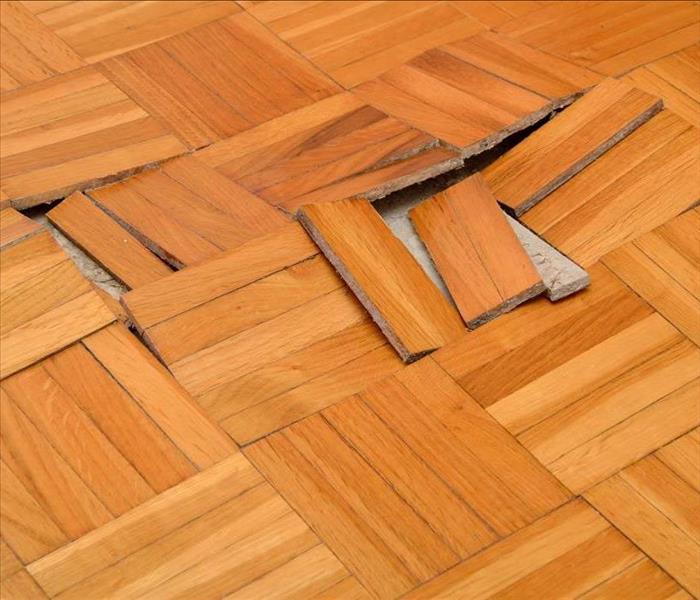Does Water Intrusion Ruin Hardwood Floors in Chicago?
2/10/2022 (Permalink)
 SERVPRO's rapid removal of water-soaked hardwood flooring in Chicago may prevent demolition and expensive construction
SERVPRO's rapid removal of water-soaked hardwood flooring in Chicago may prevent demolition and expensive construction
SERVPRO is a Specialist Water Removal Firm that Can Restore Hardwood Floors in Your Chicago Home.
Does Moisture Harm Wood?
Many Chicago properties have hardwood finishing on their floors. These are typically constructed from dense, valuable, and semi-porous materials. To correct and mitigate damages to floor finishing, production technicians need to understand how water affects these materials.
There are two influential variables when attempting to restore water-damaged Chicago hardwoods: permeance, the amount of porosity of a material, and the length of exposure. Permeance is when water travels through the flooring, usually working into materials through capillary suction and wood grains. The size of exposure can often be mitigated by reaching out to a professional restorer as quickly as possible and putting in place the correct drying procedures. SERVPRO promises to arrive on-site within four hours of notification of loss to mitigate lengthy exposure times.
What Happens When Floors are Exposed to Moisture?
When water intrusion occurs, it is vital to enact water removal and hardwood floor specialists for your Chicago home. Natural materials have a moisture content level, usually around 12%, that allows them to retain their natural shape and structure. As exposure to moisture increases, laminates or varnishes can wear away, leading to direct exposure of non-protected wood grains to moisture. As these materials absorb moisture, they can begin to expand or change shape, putting extra pressure on joints, warping the floors, or leading to buckling, cupping, and crowning. The quicker we can remove moisture from your floor, the less harm occurs to natural materials. Some effects of water exposure, such as crowning, are considered non-restorable. Crowning can lead to sourcing and replacing expensive hardwood floors.
How Do Restoration Services Return Hardwoods to a Pre-damage Condition?
- Stripping the floor to ensure an even finish and drying it to its average moisture content level
- Sanding the floor to negate the effects of warping, buckling, or cupping
- Refinishing the floor with a varnish or polymer to return it to its normal, pre-damage condition.
When are Wet Hardwood Floors Repairable?
Providing that the hardwood floor's moisture content levels do not exceed 5% of its natural level, there is a strong chance of restoration. SERVPRO technicians can use truck-mounted equipment to extract water immediately from the hardwoods surfaces and reduce exposure times. If there are carpets, we can remove these along with the carpet pad to allow the floorboards to air. Air-movers can be valuable equipment for the restoration of these materials. Our technicians may frequently adjust them to push air beneath the flooring, into crawl spaces and cavities, or run air over the surface level. In some situations, small holes may be drilled into the hardwood's surface to allow for additional equipment and drying. While these may cause light cosmetic harm, they are often essential to ensure that most structure is saved.
What are the Useful Techniques for Drying Hardwood Floors?
- Do not sand floors until completely dry, as these materials could continue to expand or contract under the influence of moisture.
- To measure the extent of water absorption, Teflon-coated moisture probes are used to read moisture migration through wood layers.
- Desiccant dehumidifiers use a silica gel to reduce relative humidity below 40GPP and assist in the hardwood surfaces' drying process.
How are hardwood floors dried quickly?
It is not uncommon for woods to remain wet after the rest of the home's structure and contents are dry. One way to improve the drying times of hardwood surfaces is to erect a smaller drying chamber. SERVPRO technicians can place thick, poly sheeting over the surface using either sandbags or duct tape to seal the edges. An air-mover, dehumidifier, or portable heater can then be attached to the sheeting, inflating it and creating a drying tent. Drying tents allow for concentrate drying by providing a smaller cubic feet chamber. These drying tents often allow technicians to dry below the surface level and through the layers of woods. Ensuring that the wood flooring is completely dry before sanding and refinishing is an essential part of mitigating the wet hardwood floors' losses.
What Mitigation Strategies are Used to Prevent Crowning, Buckling, and Warping?
- Immediately reduce the relative humidity to 30% to 45% using a drying chamber or desiccant dehumidifiers.
- As moisture content readings drop below 16%, use air-movers to increase the evaporation process.
- Finished flooring can inhibit water evaporation by creating a vapor barrier. Stripping a floor can help to increase drying times and provide an even surface for refinishing.
Hardwoods are often treatable, if not curable, after water exposure by using correct drying equipment and application of drying theory. Contact SERVPRO of West Loop / Bucktown / Greektown at (773) 434-9100.






 24/7 Emergency Service
24/7 Emergency Service